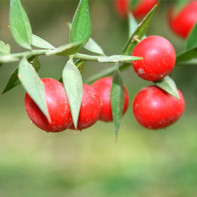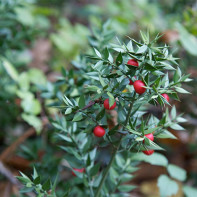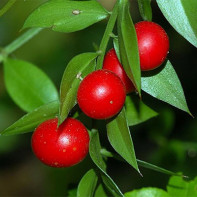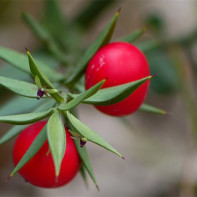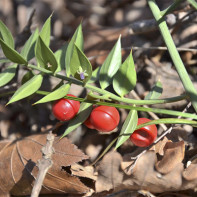Iglitz: medicinal properties and contraindications
Iglitz (russet, mouse thorn) is a perennial shrubby plant that belongs to the Asparagus family. Previously ranked in a separate family Iglitzes. There are several varieties of the shrub. Some are used in folk medicine, others are used as feed for livestock. It is also used to make green hedges and is planted in parks and gardens. The young shoots of this plant are suitable for eating. Some peoples eat the fruit as well.
- Chemical composition
- What it looks like and where it grows
- Types of
- Harvesting and storage
- Therapeutic properties of needlewort
- Needlewort in folk medicine
- When hemorrhoids
- With swelling
- Root extract
- Kinds of medicinal compositions
- Infusion
- Infusion
- Decoction
- Cosmetic Applications
- Home cultivation
- Contraindications to use
Chemical Composition
The plant has a number of positive properties due to its rich composition. In the upper part of the plant, including the berries, there are such elements:
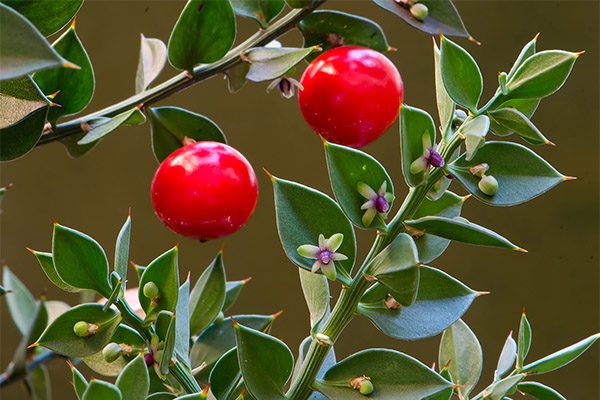
- Calcium. One of the most important elements for the human body. It plays an important role in the formation and maintenance of bone tissue in a healthy state. It is also important for the teeth. In addition, it takes part in the processes of muscle contraction. For example, cramps can be caused by a lack of this element. Calcium can fight cholesterol by blocking intestinal absorption of saturated fats.
- Chromium. This element takes part in many processes in the body, but its influence is most noticeable in maintaining normal blood sugar levels. Chromium is also a prophylactic for some diseases of the cardiovascular system. Chromium deficiency can cause headaches, vision problems, and impaired growth.
- Manganese. The daily requirement of the body for this material is small, but it is still there. Manganese is necessary for the heart, thanks to this element some B vitamins, necessary for the normal functioning of the digestive system, are assimilated better. Manganese also reduces the risk of diabetes. But in large quantities, it can do more harm than good.
- Phosphorus. Responsible for the development of bone tissue and tooth enamel. This element ensures normal muscle function and mental activity. Phosphorus deficiency can make a person feel tired and weak.
- Potassium. Potassium is involved in maintaining water balance in the body and normalizes the rhythm of the heart. It also better oxygenates the brain, improving its performance, useful for allergies, and is necessary for the normal functioning of soft tissues, including muscles and blood vessels.
- Iron. Another very important element for health. Iron is a part of hemoglobin and is involved in the oxygenation of body tissues. Without this element it is impossible to breathe at the cellular level. It also participates in metabolism and helps to eliminate toxins from the body.
- Magnesium. Most organs need this element. It is present in the brain, teeth, liver, kidneys, and even muscle tissue, helps the absorption of B vitamins, has a calming effect on the nervous system, is recommended for women with PMS, and prevents the risk of cardiovascular disease.
- Silicon. It plays an important role in the body, improves the metabolic process, is involved in strengthening blood vessels, helps with toothaches and stomach disorders, raises immunity and lowers blood cholesterol levels.
- Cobalt. It participates in the breakdown of proteins and DNA synthesis, normalizes metabolism and stimulates hematopoiesis, is responsible for normal functioning of the pancreas and regulates the production of adrenaline.
- Vitamin C. It is able to fight toxins and remove them from the body, strengthens the immune system and increases the body's defenses against viruses and bacteria. It is also called the almighty vitamin, because it strengthens blood vessels, has a beneficial effect on the nervous system and skin.
- Vitamin PP (nicotinic acid). It improves blood circulation, takes an active part in metabolic processes and respiration. It is also a useful element for skin and hair.
- Plant fibers. They take part in digestive processes and are the prevention of some diseases of the gastrointestinal tract.
Despite such a rich set of useful elements, the roots are mainly used for medicinal purposes. They are concentrated in such substances:
- Saponosides. They have an anti-inflammatory effect and can remove edema, strengthen the walls of blood vessels, but at the same time narrow them, promote the resorption of blood clots.
- Heterosides. They improve brain activity, increase some blood flow, saturate tissues with oxygen, so they are useful for depression, headaches and other diseases of the nervous system.
How it looks and where it grows
There are several varieties of the plant, which differ from each other in appearance and size. Some varieties are grown in gardens. In folk medicine, prickly needle, also called pontica, is used. It can be grown even in room conditions.
Spiny Needlegrass is an evergreen shrub characterized by erect stems. From the main stem, there are branches on which there are leaves. Its height usually varies from 30 to 60 cm, but sometimes it can be up to 1 m. The plant has modified shoots that are shaped like leaves. Their structure can be matte or glossy, they have an ovate shape, pointed at the ends.
The leaves of the plant are also unusual. They are small in size and triangular in shape, and are formed on modified shoots. From the side it looks as if one small leaf is growing on another, larger one.
The flowers are small, light blue, sometimes with shades of purple. Their blooming period is quite long. After the flowers wither, fruits are formed, colored in a rich red hue. They are rarely more than 10 mm in diameter. The fruit ripening period falls in November and December. There are several seeds inside the fruit.
It grows in southern regions with warm winters. It is found on the coast of the Black Sea, in Turkey and southern Europe, on the territory of Crimea and the Caucasus.
Species
At the moment, except for prickly needle, there are 4 species of the plant, each differing not only in appearance, but also the habitat:
- Spiny Needlewort (Italian). Externally, the shrub is similar to the prickly variety. The stems of the plant are straight, can reach 50-60 cm in length. The leaves are oblong, painted in a rich green hue. Flowers are white or slightly bluish, appearing in February and March. In the wild grows on the coast of the Mediterranean Sea. Most often found in North Africa and the Iberian Peninsula. Grows in the shade of trees, in moist soil.
- Elysium hypoglossum. A shrub with erect stems up to 40 cm tall. The bract consists of 6 petals, which have an oblong shape, resembling a tongue. There is a small purple flower in the middle. The modified shoots can reach 2 cm in width. The flowering period falls in May and fruiting lasts from August to December. It is found in Central Europe, Asia Minor and the Balkan Peninsula. In Russia, it occurs only in the southern part of Crimea. It grows in groups or singly in places with high humidity in the shade.
- Iglitsa colchicum. This species is considered endangered. The plant has straight stems, not branched, which can reach 4 cm in width. The leaves are small, resembling an awl. The shrub can reach 60-70 cm in height. The flowers are white, located in the lower part. Occurs in Georgia and Turkey. In Russia you can find it only on the coast of the Black Sea. This species is unique in that it blooms almost the whole year. The first flowers appear in October and November, and fruits in March. In summer, repeat flowering is often observed.
- Hirkanum iglica. A perennial plant with straight shoots that can reach 40-50 cm in height. One bush may consist of 3 main stems and several offshoots. The plant is included in the Red Book as an endangered species. It grows on the territory of Azerbaijan and Iran, in small quantities is found in the southern part of Crimea. Since the shrub grows in arid regions, the fruits grow small. They have a rich red color and ripen in mid-autumn.
Collection and Storage
For medicinal purposes, mainly the roots of the plant are used. Folk medicine uses for treatment both decorative varieties and wild-growing ones.
The roots are collected in the fall. Since the shrub usually grows on wet soils, there should be no problems with obtaining medicinal raw materials. Collect the roots should be in limited quantities to avoid the degeneration of needlewood. If the weather permits, it is better to spread the roots outside under a canopy. It is advisable to avoid sunlit places. Otherwise, dry the roots in the attic, opening the windows to provide access to fresh air.
Prepared raw materials should be crushed to a powdery state. To do this is not difficult. First, chop the roots in small pieces, then pass through a coffee grinder or put the finely chopped raw material in a bag and grind well with a rolling pin. The preparation should be stored in a glass jar in a dry place. Under all conditions, the root can retain its positive properties for a year.
Medicinal properties of Needlewort
Needlewort has occupied its niche in folk medicine. It is used to treat various diseases.
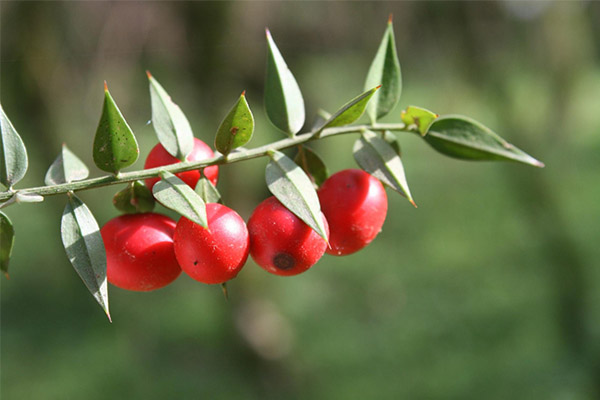
- This plant helps to fight inflammatory processes in the body. Compounds contained in the plant can not only suppress inflammation, but also heal the damage caused by them.
- Iglitza can treat chronic venous insufficiency. In this disease, the veins in the legs have difficulty returning blood to the heart. The compounds in the plant improve the contraction of the veins, thereby helping the blood to return to the heart.
- Older people often experience a sudden drop in blood pressure when they get out of bed abruptly. Studies have shown that needlewood can help with this problem because of its ability to constrict the veins.
- Hemorrhoids are one of the common problems among the elderly. Folk medicine successfully uses medicines based on this plant to treat hemorrhoids and other vascular diseases. The plant is valued for its ability to relieve swelling and improve vein contraction.
- Iglitza lowers the risk of blood clots and blockages in blood vessels. It is able to remove toxins from the body, restores water-salt balance and improves blood circulation.
- Eggplant is also widespread in cosmetology. Both roots and fruits are used for this purpose, and extracts are made by evaporating useful substances. The plant is able to stimulate intracellular metabolism, which prevents the development of cellulite, tones smooth muscles and takes care of the skin. The extract from the roots is often added to skin care products for feet.
- The plant often becomes a component of cosmetics for facial skin care. Eggplant helps fight dark spots under the eyes and eliminates bulging fatty tissue in the lower eyelid.
- Some body scrubs also have needleberry extract in their composition. The plant allows you to restore skin elasticity, makes it smooth and gets rid of age spots.
- In medicine, needlewood extract is part of some preparations that help with nervous disorders, cardiovascular disease and problems with the organs of vision.
Iglitz in folk medicine
Despite the great usefulness of the plant, there are a limited number of recipes in folk medicine. The fact is that in pharmacies they sell both ready-made tinctures and extracts.
When hemorrhoids.
For this purpose, it is recommended to take a tincture of the plant. It has anti-inflammatory properties and is distinguished by its ability to improve the contraction of the veins.
To prepare it, take 20 grams of ground roots and mix with vodka in a ratio of 1:10, then cover tightly and insist for 4 weeks in a dark cool place. Strain the finished medication and drink 10 drops diluted with water, three times a day before meals.
When swelling
To this end, use a decoction, which has a strong diuretic effect. From this decoction apply compresses to the painful place with varicose veins. It can also help women to alleviate the condition during menopause and PMS.
To prepare it, you will need 7 g of powder and 200 ml of boiling water. Pour the root in a glass container with boiling water, then put in a saucepan and fill with water to the level of liquid in the glass. Boil in a water bath for 10-15 minutes. Cool the medicine to room temperature, then strain. Drink 20-30 ml three times a day before a meal. When varicose veins, rub the decoction on the legs several times a day.
Root extract
The extract is able to improve blood circulation, helps to eliminate toxins and waste from the body. Effectively removes black circles under the eyes, improves vascular strength.
First you need to prepare the water. It must be clean and free of any impurities. It is possible to distill it at home. To do this, you need to collect water in a pot, then place an empty bowl inside. It is important to choose a container so that during the boiling water drops do not fall into it. Next, cover the pot with a concave lid and place ice on its surface, which will cool the distillate and improve condensation. During the boiling process, the water will turn into pure steam and settle in the bowl. Then mix purified water with glycerin (the rate of glycerin depends on the desired consistency of the finished product and can vary from 10 to 60%).
Next, you need to mix the crushed roots of the plant with water-glycerin solution in a ratio of 1:5. The extract should be kept in a dark and cool place for 14 days. Stir the medicine daily. Store in a dark container. Shelf life without adding preservative does not exceed 21 days. The extract can be added to cosmetic preparations or used pure.
Types of medicinal compositions
Very often in folk medicine use needlewood for the treatment of varicose veins. From the roots of this plant are prepared infusions, decoctions and tinctures.

Infusion
The infusion has an anti-inflammatory effect. Folk healers recommend it to women to get rid of discomfort caused by premenstrual syndrome. This remedy can also help with hemorrhoids. Iglitza relieves discomfort and generally has a positive effect on varicose veins. The infusion also has a diuretic property.
To prepare the infusion will need 1 tbsp of medicinal raw materials and 1 liter of boiling water. In a glass container to put the powder from the root of the plant, then pour boiling water, cover and let stand for 3-4 hours. Then strain the liquid through folded gauze several times. It is desirable to do this several times, that no powder remained in the infusion. Drink 2-3 times a day before a meal in small portions.
Tincture .
Tincture is used with venous insufficiency. It is able to relieve the discomfort caused by this disease (pain, cramps, swelling). It has anti-inflammatory properties, it is recommended to drink for hemorrhoids, kidney or gallbladder problems. Tincture can help with jaundice, gout, but in this case you should first consult a doctor.
Prepares a 10% tincture of powdered roots of needlewort. Require 50 g of raw materials and 0.5 l of vodka or 40% alcohol. Pour the roots of the plant in a glass jar with vodka, then cork tightly and insist for 14-20 days, shaking occasionally. Once it is ready, strain through heavy gauze several times and pour into another glass container. Store the medicine in the refrigerator. Drink 10-15 drops three times a day before meals.
Decoction .
Used to treat edema, cramps and lymphatic congestion. Folk medicine advises to drink the decoction for women to get rid of discomfort during menopause. The decoction has a diuretic effect. It is also drunk to cleanse the body of toxins.
To prepare, you will need 10 grams of powder from the root and 250 ml of boiled water at room temperature. Pour the powder into a saucepan, pour water and bring to a boil over low heat. Boil the medication for 15-20 minutes, then insist until cool and strain thoroughly. Drink in small portions throughout the day.
Cosmetic applications
Cosmetological remedies on the basis of needlewood are successfully used for more than one year. The plant is able to effectively treat couperose - a disease characterized by the appearance of dilated capillaries on the skin. It appears because of impaired blood circulation. The effectiveness of the plant is due to its antiseptic and anti-inflammatory effect. Iglitsa is also capable of destroying bacteria. At the same time, the treatment is not limited to the elimination of symptoms, the plant can also eliminate the causes of the disease.
Do not forget about the ability of puffball to fight cellulite. The plant activates blood circulation, improves metabolic processes and stimulates cell regeneration. It also helps to successfully fight stretch marks.
To improve the condition of the skin, you can use an extract of the plant. In pharmacies they sell ready-made, but you can make it yourself. The extract comes in two types:
- Macerate. In Latin it means "soaked". It is obtained by soaking the plant in liquid (water, alcohol, oil).
- Infusion. It is the process of extracting useful substances from the plant with the help of liquid.
The second method is used more often than the others. To prepare an extract, you will need the berries or roots of the plant. Also sometimes use flowers. Then heat the liquid (without bringing it to a boil) and pour the raw material into it, and then insist for several hours. Then the infusion must be strained and stored in bottles. It can be added to cream or shampoo.
You can also add fresh berries to cosmetics. To do this, you need to peel them, take out the seeds, then crush them into a pulp and add them to the cream for hands, feet or face. Such a cream can be smeared on the circles around the eyes.
With heavy legs, varicose veins and other problems, you will need an extract from the roots of needlewort. It can be used as an independent means, applying compresses to the sore spot, and paired with a cream for the feet. In this case, mix the extract with the cream to keep the thick consistency.
Folk healers advise dabbing the skin around the eyes with the juice of fresh berries. They can also be consumed in food.
The extract is also successfully used in the fight against cellulite. To do this, you need to smear problem areas with the extract from the roots of the plant in water.
Home cultivation
There are mentions that the butte grew on the planet even before the Ice Age. Now this plant is not very common, some species are even recognized as endangered, nevertheless, it can be found not only in gardens, but also in apartments.
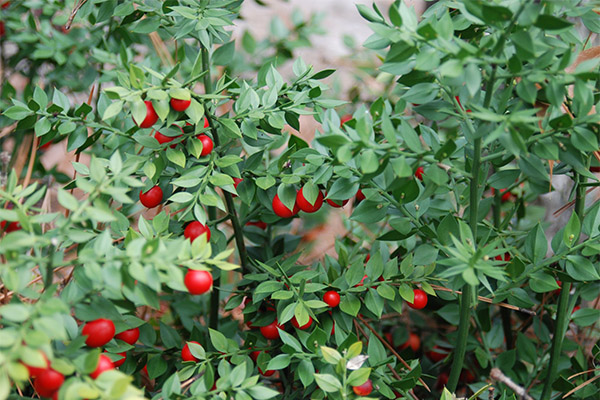
Eggplant can be grown as a shrub or as a miniature tree. In any case, it will remain a beautiful and attractive plant. It does not require special care, even a novice gardener can cope with this. In March, the plant begins to develop intensively, so it is important to provide all the conditions in this period. Firstly, it is necessary to apply mineral fertilizers, which are used for flowering crops, at intervals of 20 days. Secondly, provide regular watering. On the fulfillment of these requirements depends on what kind of shoots will be.
During the manipulation of the needlewort, you need to be careful not to damage the young shoots, otherwise their growth will stop and will only continue next year.
You can place the plant in the room almost anywhere, in the shade or in a bright area. But it must be protected from direct sunlight. This is the reason why plants die in the wild. They usually grow in the shade of trees, and when forests are cut down, they die in the sunlight.
In summer, the pot with needlewort should be placed on the northern window, and in winter on the southern window.
There are no requirements for air humidity. It grows equally well in humid air, and in dry air. But in summer it is still recommended to spray the shrub a little from a sprayer. It is desirable to do this procedure at least once a week.
The required temperature depends on the time of year. When the weather outside is warm, the room temperature should be from 19 to 24 degrees Celsius. In winter the figures are slightly lower - 13-16 degrees.
Profuse watering is required only in the spring, when the shoots are growing. During the rest of the year, it is enough to add water when the soil begins to dry out.
When the shrub becomes cramped in the pot, it is recommended to transplant it to a deeper container. You can make the bush lush by planting it in a wide container. This will allow new shoots to grow from the root. You can plant puffer plants in any soil, except for clay soil. Another requirement for the soil - it should not be too dense, otherwise a lot of water will accumulate on the surface.
When growing in the garden, the pine needle can be affected by various pests. If any traces of their presence are detected, it is necessary to treat the plant. Garlic tincture helps a lot in this case. To prepare it, you need to crush 2 heads of garlic, put them in an airtight container and pour 1 liter of water. Tincture to stand for 5 days, then additionally mix with 1 liter of water. You can also use special biological preparations.
Contraindications for use
Iglitsa is successfully used in folk and traditional medicine. This is an incredibly useful plant, which is not devoid of contraindications. Because of its ability to constrict blood vessels, it is not recommended for hypertension. It is also forbidden to use it during pregnancy and breastfeeding. Children taking this plant is also not desirable.
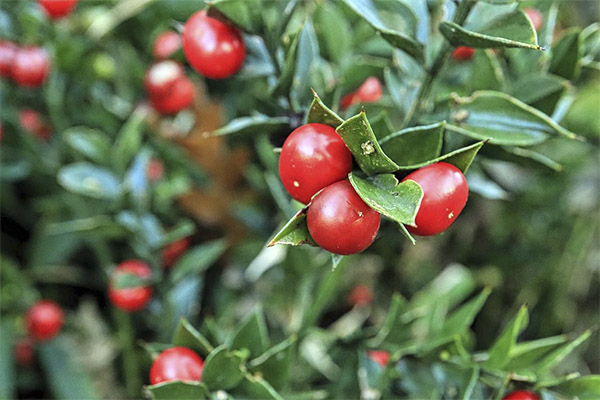
Eggplant has anti-inflammatory properties, but it is not advised to drink it in case of inflammatory processes of the urinary tract.
In the case of venous stasis, it is necessary to definitely consult a doctor. In the absence of these health problems, it is still recommended to consult a doctor before using medicines based on this plant. In some cases, there may be an individual intolerance of some components or an allergic reaction. Before drinking medicines from this shrub, you should check the absence of allergies by applying a small amount of decoction or infusion on the skin.
In case of overdose, symptoms of poisoning may be observed, including nausea, vomiting and diarrhea. In this case it is necessary to take activated charcoal at the rate of 1 tablet per 10 kg of weight.
It is not only a useful plant, but also a beautiful decorative element. Gardeners and designers appreciate the needlewort for its ability to bloom for a long time. It gives a room or garden an amazing look, and it is not difficult to grow. In addition, it bears useful berries. Many cosmetic companies use the plant's extract as an ingredient in some products. For example, L'Oreal adds needleberry to its face cream.
«Important: All information on this site is provided for informational purposes only purposes. Before applying any recommendations, consult a specialist specialist. Neither the editors nor the authors are liable for any possible harm caused by materials."

